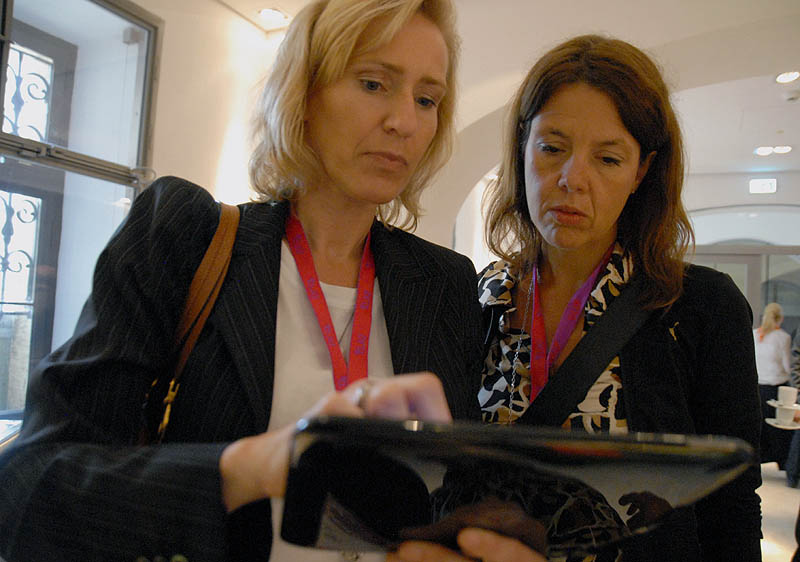
Image by Innovate 360. Licensed for reuse under Creative Commons.
By Steven McGinty
In the first of two articles focusing on technology in health and social care, I will be looking at some of the barriers organisations face in adopting digital technologies. Financial pressures such as the reduction in public spending, as well as an ageing society, mean that health and social care will be expected to meet greater levels of demand with fewer resources.
The UK Government believes that the implementation of technology is the solution to helping the health and social care system become more efficient and more effective at delivering patient care. However, before health and social care can reap the benefits of technology, a number of barriers have to be broken down.
Information sharing challenges
Integration has been a main focus of health and social care in England, as well as the devolved administrations. If integration is to work successfully, different organisations must be able to share data securely. At the moment, data is recorded in a variety of ways across a number of different IT systems. We also have a situation where the main method for sharing data securely in local authorities, the Public Services Network (PSN), is not fully integrated with either the NHS in Scotland or England. Eddie Copeland, of the Policy Exchange, suggests that full integration of the NHS with the PSN should be seen as a priority.
Financial costs
The financial costs of rolling out new technology within an organisation can be significant. These costs can include the procurement of hardware and software, internet connections, and the training of staff. For organisations which are undergoing major budgets cuts, it may seem very difficult to justify the investment in technologies, even if there is the potential for savings in the future.
Management issues
The importance of technology in organisations can be underestimated by decision-makers. For example, according to Martin Ferguson, Director of the Society of IT Management (Socitm), the ICT challenges involved in introducing the new Care Act in England are not being given enough priority. He highlights that if organisations are unable to share information safely by April 2015, they risk failing to comply with new reporting regulations.
Local authorities can also have policies that restrict the use of technology. A recent Skills for Care report into the digital capabilities of social care found that local authorities are still wary of certain technologies, including cloud based systems, which can offer low-cost solutions, and social media, which can lead to savings for local authorities if used correctly.
The health and social care workforce
The Skills for Care report highlights that over 95% of staff feel they are confident in basic online skills. However less than a quarter of managers believe that they have staff with enough skills to make use of digital technology. This mismatch means that managers may be hesitant to introduce new technologies over fears that staff may have difficulties in using the technology, as well as the costs associated with staff training.
There is also a suggestion that social care staff may be resistant to the introduction of new technologies, due to concerns that introducing technology may over-complicate things and move the focus away from the patient. As we noted in a recent article on digital services within government, a key part of introducing any new technology is changing the mindset of staff and having effective leadership in place to champion it.
These are just some of the challenges associated with introducing digital technologies into health and social care. In a future article, we will look more at how technologies can be used within health and social care and the benefits they can bring to organisations. We also look at a case study of an innovative technology partnership between Calderdale Council and Idox, which is addressing the shared services agenda in social care.
Further reading:
- What is stopping a digital revolution in health and social care? (Guardian 2014)
- Spending cuts have left the NHS and social care in crisis (Guardian, 2014)
- Later Life in the United Kingdom (Age UK, 2015)
- Personalised Health and Care 2020: Using Data and Technology to Transform Outcomes for Patients and Citizens – A Framework for Action (HM Government, 2014)
- Small Pieces Loosely Joined: How smarter use of technology and data can deliver real reform of local government (Policy Exchange, 2015)
- ICT challenge of health and social care integration “not given priority” (UK Authority, 2014)
- Digital capabilities in social care (Skills for Care, 2014)
- Councils seeing financial benefit of social media finds report (Localgov, 2014)
- 3 common barriers to the uptake of technology (and ideas for solving them) (iCareHealth, 2014)
Share
Related Posts
By Donna Gardiner While free school meals (FSM) have been available in England on a means-tested basis since 1944, recent years have seen a renewed focus upon the potential benefits of providing free school meals to all school-aged children. Currently, ....
Today sees the start of Community Garden Week 2023. Across the UK, communities will be celebrating the many and varied types of community gardens, from children’s and neighbourhood gardens to therapy gardens and allotments. The benefits of community gardens are ....
By Hollie Wilson At the start of 2020, an independent review was published setting out what needed to be done to bring about changes to the care system for children and young people in Scotland. At the heart of the ....
The “No Wrong Door” (NWD) programme means exactly that – there is no wrong door to turn to for young people seeking support. NWD works on several core principles, which include working with young people’s birth family or guardians, allowing ....
